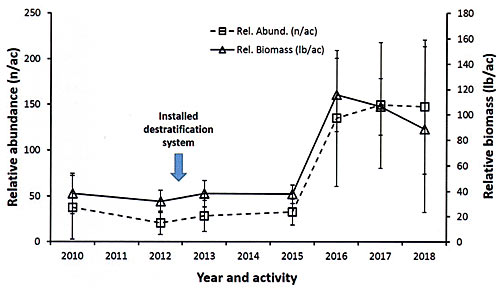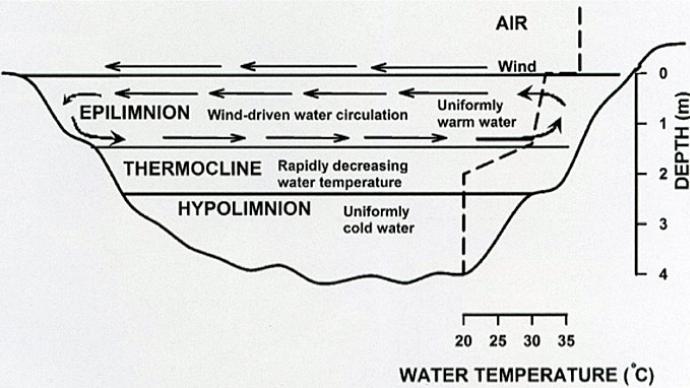
Anoxia, or the lack of oxygen, can form in deeper water layers during warmer months. This is because cooler deeper water is heavier than warmer surface water, and this density difference prevents vertical mixing when the wind blows across the surface. The deeper water becomes isolated, and without contact with the air or the oxygen-producing phytoplankton found in the shallow layers, oxygen levels in deeper areas decline. This reduces available fish habitat and increases the risk of oxygen depletion and fish kills.
Pondmeisters often use destratification systems in ponds and lakes to prevent, or at least reduce the risk of, oxygen-related fish kills. Destratification is the action of breaking up the temperature and density difference, thus allowing the pond to mix, even during warmer months. A common design uses an air compressor on the shore that pumps air through hoses on the bottom of the pond to diffusers. Air released in deeper waters cascades as a column of small bubbles to the surface, expanding and pushing water upward. Thus, deeper water rises to the surface and surface waters sink to replace it, creating a vertical circulation effect. The water is oxygenated in the process as it contacts the atmosphere.
There have been a handful of studies on the physical and biological effects of destratification. These papers reported improved habitat, reduced fish kills, greater rates of decomposition, and increased production at lower trophic levels in response to destratification. In theory, fish production may increase due to the increase in available habitat and increase in food availability, but no direct research has addressed this hypothesis.
That is, until now.
In this month's installment of Empirically Speaking, I describe the curious case of Blackjack Pond. This 5-acre lake is located on the campus of Mississippi State University and is used for teaching and research. The lake has been studied a long time, so when Blackjack Pond was fitted with a destratification system, I was able to observe how the Largemouth bass carrying capacity changed.
Sport fish carrying capacity in ponds is the weight of sport fish a pond can consistently support. We often measure this as relative biomass, which is measured in pounds per acre. Relative biomass will fluctuate a little bit, but on average, it is stable as long as the productivity of the pond stays the same, regardless of the size structure of the fish population. For example, say that an unfertilized pond can support 50 pounds of bass per acre. Maybe there are 5 ten-pound bass or 50 one-pound bass, but there is 50 pounds total unless you start fertilizing or feeding.
Relative biomass has been measured in Black-jack Pond most years from 2010 to 2018. Each year, an electrofishing boat collected Largemouth bass, which were measured, weighed, and marked with a fin clip before release. The bass population was re-sampled about 4 weeks later looking for marked fish. I used the ratio of marked to unmarked bass and the number offish originally marked to estimate the population size of bass. The mean weight multiplied by the population size estimated total biomass of bass.
Divide total biomass by surface area, and you have relative biomass.
In 2012, a manufacturer donated a destratification system to Mississippi State University. The system was designed by their engineers specifically for Blackjack Pond and consisted of five bottom diffusers strategically placed in the pond and supplied by a compressor cabinet on the shore. This system was installed and activated in November 2012. Because we know the relative biomass for the period before and after destratification, we can make some inferences regarding the effects of the destratification.
It is important to point out here that this research occurred in a single large pond. Researchers normally use multiple lakes, or replicates, to eliminate any random effects of weather, location, etc. Unfortunately, replication was not feasible, so I present the results as a case study and recommend further research before drawing conclusions. That being said, I found some very interesting results.
Relative biomass of the stock-sized Largemouth bass population in Blackjack Pond averaged about 35 pounds per acre over three years prior to installation of the destratification system and remained low (about 38 pounds per acre) for three years after installation (Figure 1). Population size was also consistently low during this period, with estimates ranging from 21 to 38 bass per acre. Suddenly in 2016, relative biomass tripled (116 pounds per acre) compared to previous estimates, and population size (135 fish per acre) increased about 400%!
At first, I thought this was an anomaly, and that the population would soon return to normal. However, relative biomass remained high in 2017 (106 pounds per acre) and 2018 (89 pounds per acre). Sure, it dropped slightly, but was still 230% higher than before destratification. The number of bass increased slightly in 2017 and stabilized near 150 bass per acre.
Concurrent to the increases in relative biomass and abundance, the average weight per bass declined precipitously. Mean weight of individual stock-sized Largemouth bass peaked at about 1.5 pounds just before the destratification system was installed and dropped every year afterwards to 0.6 pounds in 2018. Fish were getting skinnier, too, dropping from a relative weight (Wr) of 88 to 74 in three years (Figure 2). That means they weighed 88% of what a healthy fish would in 2015 (a little thin) but dropped to 74% by 2018 (really thin).
No other activities in or around Blackjack Pond can explain why relative biomass tripled in 2016 and remained high to present day.
So, what was going on?
First, I believe that the action of continuously mixing the pond has increased the carrying capacity. Maybe it was as simple as increased habitat availability during the summer. Often, waters deeper than 4-5 feet have very low oxygen in the summer months, restricting fish to the warmer, shallower waters. This limits food availability and increases metabolism. Destratification could double available summer habitat and lower energy costs by keeping fish cooler.
Maybe it was a little more complicated. Destratification can affect the physical and chemical function of ponds that, in turn, can influence biological productivity. Research has demonstrated destratification affects thermal and oxygen patterns, chemical processes, and nutrient dynamics, among other things. One study reported that productivity was three times higher in lakes when aerated, and this increased production should be transferred up the food web.
You may be asking why it took three years to see an effect. When carrying capacity increases, the population must grow to fill it. Usually this involves recruiting new fish. The system was installed after spawning season in November 2012 when the pond was already naturally destratified, so the first period of summer destratification would have occurred in summer 2013, after the 2013 spawning season. Thus, the first spawning event following full destratification would have occurred in spring 2014, and these fish would have entered into the adult population by spring 2016 when biomass increased.
The data also suggest that the increase in biomass may have initially exceeded the new carrying capacity in Blackjack Pond. In other words, when carrying capacity increased, bass reproduced to fill the void, and they might have been a little over-enthusiastic. Blackjack Pond is not generally fished or harvested, so the surplus bass remained in the pond and depleted their prey resources. Skinny fish are a telltale sign of not enough food to go around. Nature has a way of bringing the population back in balance with carrying capacity.
Time will tell where the new carrying capacity will stabilize, but for sure this study suggests that continuous destratification may increase carrying capacity for Largemouth bass. I suspect that Blackjack Pond will stabilize around 70 to 80 pounds per acre—more than double pre-destratification levels. I will keep studying the lake and will update you again in the future!
Reprinted with permission from Pond Boss Magazine



